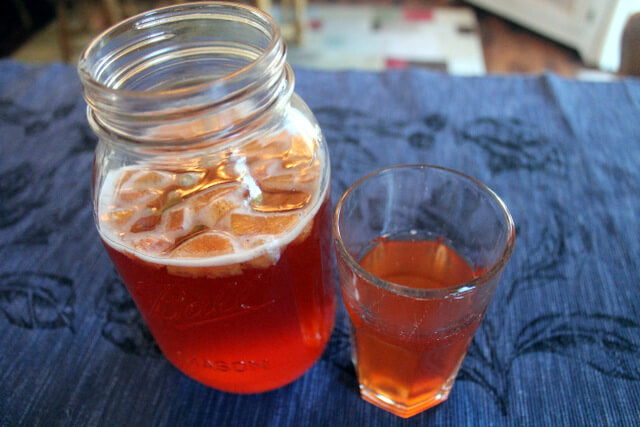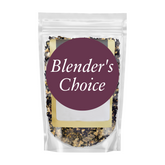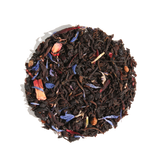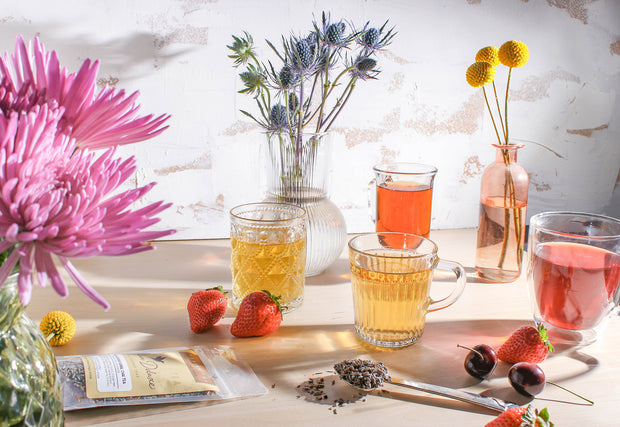
What is Kombucha?
A beverage of ancient origins, kombucha is sugar-sweetened tea fermented for seven to fourteen days using a Symbiotic Culture of Bacteria and Yeast, aka SCOBY. A good homemade kombucha should taste like a tangy, effervescent cold-brewed tea, the flavor notes depending on what type of tea and infusions (more about that later) that are used.
Best Types of Tea for Kombucha
Choosing a great tea for your homebrew is important for both flavor and drinkability. Organic, loose-leaf Royale Black Tea and Royale Green Tea make excellent kombucha. Note: Avoid tea blends with essential oils or chemical flavorings, such as Earl Grey or Chai, as well as herbal teas that don’t contain any Camellia sinensis. They may weaken your SCOBY over time.
Bringing Home SCOBY
A good-quality SCOBY is essential for a healthy ferment. This thick mat of bacteria and yeast is usually creamy white with dark brown strands and soft, rubbery textures. If you don’t have a friend or a local homebrewer who can pass one along, you can purchase a SCOBY at a reputable supply store or online kombucha retailer. One of my favorite online resources is Kombucha Kamp.

How to Brew Kombucha at Home
Makes about one gallon
Equipment:
- Stock pot
- 1 1/4 gallon glass jar (fermentation vessel)
- Tightly woven cloth to cover the jar
- Large rubber band
- 6 16-ounce glass or plastic bottles with air-tight lids
- Small funnel
- Heart & Soul Tea Infuser or tea filter bags if using loose leaf
- Tight-mesh strainer
- 16 cups of cool, chlorine-free water
- 1 cup evaporated cane juice or plain white sugar
- 1-2 tablespoons loose-leaf Royale Green Tea, Royale Black Tea, or 4-6 tea bags/sachets
- 1-2 cups mature starter tea*
- 1 full-sized kombucha SCOBY
Directions:
First, prep fermentation vessel, utensils, and bottles. Wash in very hot soapy water (be sure to avoid antibacterial soap, it may harm your SCOBY) or a 1:1 dilution of distilled/pasteurized vinegar to water (never use raw vinegar since it may contaminate your brew).
Make the sweet tea. Bring 4-6 cups of water to a boil, remove from heat, and steep the tea for 5-7 minutes. Remove tea leaves and stir in sugar to dissolve. Add the rest of the water to quickly cool down the tea.
Once the sweet tea is cool, pour it into the glass jar and mix in the starter tea. Gently place the SCOBY inside. Cover the mouth of the jar with a few layers of tightly-woven cloth or paper towels and secure with a rubber band.
Set the jar in a warm location, out of direct sunlight. Ferment for seven to ten days, checking periodically. On the seventh day, begin tasting the kombucha until it’s the right balance of sweet and tart for you.
Remove the SCOBY along with 1-2 cups of the tea, setting them aside for the next batch. Bottle the finished kombucha using a tight-mesh strainer and a funnel, along with any herbs and/or fresh fruit for flavoring (see below for some of my favorite combinations). To carbonate, leave about a half inch of head room in each bottle and store at room temperature for two to four days before moving to the fridge.
Brew a fresh batch of sweet tea. Once cool, pour it into the glass jar, mix in the starter tea, and place the SCOBY back in. Cover and ferment. Alternatively, you can put the SCOBY and starter back into the glass jar, screw on the lid, and place it in the refrigerator; it will keep indefinitely until you are ready to start your next batch.

Flavor Infusions
While I enjoy plain kombucha, infusing it in the bottle with fruit and herbs allows me to add more flavor, depth, and color to the brew. Here are a few of my favorite blends; the quantities are for 16 ounce bottles.
Apple-Blueberry
1 tablespoon fresh or frozen blueberries, halved
1/8 cup fresh or frozen apple, diced
Lemon-Lavender
1/2 teaspoon fresh lemon zest
1/4 teaspoon dried lavender flowers
Strawberry Lemonade
2 tablespoons strawberries, chopped
1/2 teaspoon fresh lemon zest
1 spring fresh thyme

A Few More Tips
- When you first start out, stick to the recipe’s ratio of sugar, tea, starter tea, and water for the health of your SCOBY. As your knowledge of kombucha making and your own personal tastes grow, I encourage you to fine-tune and/or experiment with this recipe.
- If you’re brewing in a one-gallon vessel, reduce the amount of tea, sugar, and water by 25 percent.
It’s totally normal for the SCOBY to float in the jar, bubble, or develop brown strings, holes, and bumps during fermentation. Other signs of a healthy ferment: a sharp tangy aroma and happy burbling sounds. - Avoid prolonged contact between the SCOBY and metal, which can weaken the culture over time.
- A SCOBY will last a long time but it’s not indestructible. If a SCOBY becomes black or green, it has passed its lifespan or become infected. Throw away the SCOBY and tea and start again.

![Spring Break Tea Variety Pack [6-Pack Variety of Flavors]](http://www.plumdeluxe.com/cdn/shop/files/spring-break-pack.jpg?v=1740682266&width=165)















